Abstract
In order to achieve the goal of effectively utilizing solid waste resources and improving mining stability, it is necessary to incorporate various types of solid wastes in the production of cemented backfill. For investigating the compressive strength and damage characteristics of Cement–Fly Ash–Slag–Gangue (CFSG) cemented backfill under loading, real-time X-ray Computed Tomography (CT) scanning was employed to capture two-dimensional (2D) grayscale slices and three-dimensional (3D) fracture models during uniaxial compression testing. The study quantitatively assessed the evolution of cracks and microstructural damage in CFSG cemented backfill. The results indicate that the specimens underwent four stages of transformation, including compaction, linear elasticity, yielding, and residual deformation, during the uniaxial compression process. The specimens exhibited a measured compressive strength of 3.44 MPa and a failure strain of 0.95%. As the axial strain increased, there was an increase in 2D porosity observed in the CT images and a greater dispersion of crack distribution. A 3D model constructed from CT slices illustrated the feature of cracking expansion, with the fracture volume gradually increasing during the elastic deformation phase and experiencing rapid growth during the yielding and residual deformation phases. The damage variable, obtained from the volume of 3D cracks, exhibited a slow-growth pattern, characterized by a rapid increase followed by a more gradual rise with the increase in axial strain. This study serves as a significant reference for comprehending the micro-mechanisms involved in the damage process and cracking characteristics of cemented backfill mixed with solid wastes under external loading conditions.
1. Introduction
The utilization of backfill mining technology is a crucial approach in deep mining operations. This method plays a significant role in managing ground pressure, minimizing surface deformation, and enhancing recovery efficiency. Consequently, it has found extensive application in the mining industry [1]. The construction volume and mining depth of deep mining fields are on the rise due to the ongoing advancement of mineral mining projects in China [2]. Artificial mine pillars created through the use of cemented backfill have emerged as crucial elements in maintaining the stability of deep mines and providing structural support to the roofs of mining areas [3]. However, when subjected to elevated ground pressure and intricate environmental conditions, the rigidity and durability of the cemented backfill diminish, making it susceptible to plastic deformation. This situation presents significant hazards to the security and steadiness of deep mining operations [4].
In practical engineering applications, tailings, gangue, and waste rocks are frequently utilized as aggregates for fill material. Silicate cement is added as a binder to improve the mechanical characteristics of the backfill body. Cement, as the predominant cementitious agent utilized in the field of backfill, constitutes more than 75% of the overall filling expenses, rendering the mining of pillars a costly endeavor. Consequently, many mining enterprises strive to diminish the reliance on cement in backfill operations to mitigate expenditure [5]. If the cement content in the backfill material is insufficient, it will negatively impact the performance of the prepared backfill material [6]. To enhance the fluidity and mechanical characteristics of the backfill slurry without escalating the backfill expenses, it is essential to incorporate a suitable quantity of chemical additives or blend low-cost auxiliary cementitious materials [7]. The advancement of national green mine construction and the utilization of bulk industrial solid waste in high-value applications have led to the increasing significance of volcanic ash materials like fly ash, granulated blast furnace slag, calcium carbide slag, and furnace slag. These materials are being used as alternatives to cement and have become pivotal in mine paste backfill research [8,9,10]. The utilization of industrial solid waste for composite cementation not only enhances the efficacy of backfill materials but also promotes rational and sustainable resource utilization [11]. This approach has garnered significant attention due to its environmental, economic, and efficient benefits. Additionally, it helps to conserve natural resources by decreasing the demand for traditional raw materials in cement production [12,13,14,15]. Therefore, the use of industrial solid waste in composite cementation aligns with the principles of a circular economy and sustainable development, making it a promising solution for addressing both environmental and resource management challenges in the mine industry.
Coal gangue is the waste rock obtained from open-pit or underground coal mining operations, usually occurring in a combination with coal [16]. The substantial release of gangue can result in significant land wastage and ecological contamination [17]. Numerous scholars have utilized gangue as the aggregate for artificial fill materials and have conducted various experiments to investigate the deformation, strength characteristics, and fracture mechanisms of the cemented backfill specimens. Yang et al. [18] utilized fly ash and cement to enhance the mechanical behavior of gangue backfill. They examined the influence of gangue particle size and mix ratio on strength and fracture characteristics. Li et al. [19] conducted uniaxial compression studies to analyze the fracture evolution characteristics and fracture failure modes of gangue waste fill and developed a structural damage model. Yilmaz et al. [20] explored the crack propagation pattern under a uniaxial load on the backfill materials through a combination of finite element numerical simulation and laboratory test results. Previous researchers also evaluated the impact of particle size of the gangue and water-to-cement ratio on the strength and cracking properties of the specimens [21]. While significant progress has been achieved in studying the macroscopic mechanical properties of backfill materials [22,23,24], the micromechanical damage mechanisms of this material remain unclear. Hence, comprehensive micromechanical experiments are necessary to examine its cracking behavior and mesostructural damage characteristics under external loading.
X-ray Computed Tomography (CT) scanning is a non-destructive testing technique that offers significant advantages, including precision, rapidity, non-destructiveness, and visualization. This method has been widely utilized in the examination of cement-based materials in recent years [25]. Many researchers have expressed interest in incorporating CT scanning technology for real-time monitoring of mechanical test procedures, in conjunction with advancements in testing methodologies. Wang et al. [26] performed in situ CT scanning on cemented paste specimens to investigate the micromechanical structural fracture characteristics and evolution process. An et al. [27] utilized CT scanning experiments to observe in real-time the cracks and morphologies of solid phase materials in slag-modified soil under loading, thereby examining the damage mechanism of the micromechanical structure. Li et al. [28] proposed a CT scanning technology to conduct micromechanical analysis under uniaxial loading conditions on coal. The study revealed the expansion pattern of destructive cracks and identified the initiation and propagation of micromechanical cracks as the primary characteristics of material failure. Sun et al. [29] performed real-time uniaxial compression and CT scanning tests on cement-based mixtures to investigate the influence of crack development on material failure properties. This study revealed a strong correlation between the crack propagation and the axial strains. The integration of mechanical testing and real-time CT scanning has emerged as a significant approach for evaluating structural damage in cement-based structures [30]. Nevertheless, there is a scarcity of literature on the application of this methodology in the realm of microstructural analysis of backfill body. The majority of prior studies in this field have primarily concentrated on crack development, without establishing a connection between cracks and structural damage as well as the stress–strain relationship. Therefore, there is an urgent need for experimental studies to delve deeper into this area.
This study involved the preparation of backfill specimens utilizing industrial solid waste, including cement, fly ash, slag, and gangue. Real-time CT scanning was performed under uniaxial loading to dynamically visualize the distribution characteristics of cracks through two-dimensional (2D) slices and three-dimensional (3D) models. Furthermore, quantitative analysis was conducted on the feature of crack evolution. Ultimately, the damage mechanism of the material was analyzed in correlation with damage variables. The research results provided a qualitative and quantitative representation of the crack evolution pattern in the CFSG cemented backfill. This submitted manuscript not only elucidates the evolutionary pattern of various testing results, but also establishes the correlation of changes in mechanical properties of backfill material cemented with mining residuals and solid wastes on different scales, representing a significant highlight and innovation.
2. Materials and Methods
2.1. Materials
2.1.1. Coal Gangue
The coal gangue utilized in this investigation was obtained from a coal mine located in Jixi, Shaanxi Province, displaying a continuous and uniform particle grading (Figure 1). After crushing and sieving, the grain size distribution curve of the gangue was determined, as illustrated in Figure 1. Particles within the diameter range of 0.02–2 mm were chosen as the backfill aggregate. Experimental results indicate that the dry density of the material is 2.37 g/cm3. According to the X-ray diffraction (XRD) experiments, the main minerals of coal gangue in the study area are quartz, illite, and mica, followed by kaolinite, siderite, and dolomite. The mineral composition analysis was conducted to ascertain the chemical constituents of the gangue, revealing the presence of SiO2 (56.7%), Al2O3 (37.6%), CaO (2.1%), Fe2O3 (2.3%), and miscellaneous compounds (1.3%).
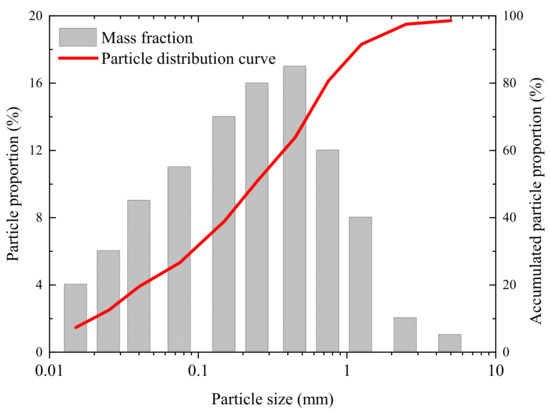
Figure 1.
Grain size distribution curve of gangue particles.
2.1.2. Cementitious Agent
The ratio of cementitious agent to coal gangue mass used for preparing the fill specimens was 1:5. The cementitious agent consisted of cement, fly ash, and slag powder in a mass ratio of 3:1:1 for cement–fly ash–slag powder, respectively. The cement is ordinary Portland cement purchased in the market, with a strength grade of P.·O 42.5. Specifically, the granulated blast furnace slag powder utilized in the study was classified as S105 grade, exhibiting a specific surface area of 425 m2/g, a loss on ignition of 2.75%, and a density of 2.31 g/cm3. The primary chemical constituents present in the slag comprised Ca2SiO4, CaAl2Si2O8, MgAl2O4, and MgSiO3.
2.1.3. Mixing Water
The backfill material was mixed using tap water sourced from the laboratory, aiming for a slurry concentration of 75% for the design specifications.
2.2. Specimen Preparation
After conducting initial research, the ideal combination ratio for the backfill materials at the mining site was determined, as outlined in Table 1, with a ratio of water-reducing agent to air-entraining agent set at 2:1. Specimens were prepared following the proportions outlined in Table 1 for mechanical testing. During the preparation process, the dried gangue particles underwent crushing and sieving, with the retention of particles smaller than 2 mm. The preparation procedure of backfill samples is presented in Figure 2. Firstly, the cement, fly ash, and slag powders were proportioned as specified in Table 1. Subsequently, they were combined with gangue particles, followed by a 90 s dry mixing process in a planetary mortar mixer. A predetermined quantity of mixing solution with a concentration of 0.2% water reducer was introduced and mixed for 180 s. The resulting slurry was then poured into cylindrical molds, each measuring 50 mm in diameter and 100 mm in length, for vibration compaction. Subsequently, the molds were transferred to a conventional curing room to undergo consistent curing at a controlled temperature and humidity. After 48 h, the molds were removed, and the curing process was allowed to progress further under ambient room temperature conditions.

Table 1.
Optimal mix ratio of gangue cemented backfill.
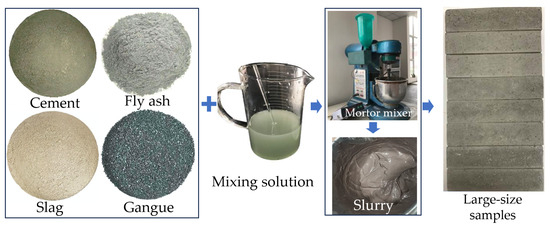
Figure 2.
The preparation procedure of the backfill samples.
2.3. Methods
To investigate the micromechanical deformation mechanism of the cemented backfill specimens, in situ CT scanning technology will be employed for monitoring and the capturing of CT images of the specimens throughout the triaxial shearing process. Subsequently, an image processing software will be utilized for 3D reconstruction and the quantitative extraction of micromechanical parameters. The Geoscan200 geotechnical in situ CT scanning platform (Figure 3a) will be utilized, comprising a scanning system, loading system, and image analysis processing system. The scanning system is equipped with an X-ray source, scanning platform, and image detector, offering a frame capture rate of 5 fps and image resolution of up to 0.1 μm. In the study, the voltage and current for CT scanning are 120 kV and 0.5 mA. Each scanning needs an X-ray exposure time of 36 min. The pressure chamber of the loading system (Figure 3b) is constructed from aviation-grade aluminum and is furnished with various sizes of loading platforms designed for accommodating standard cylindrical specimens with diameters ranging from 20 to 100 mm and lengths from 40 to 200 mm. The loading chamber exerts pressure on the samples via a pressure control system. The execution of the experimental design pertains to the initial in situ CT scanning pre-experiment carried out on backfill specimens by the applicant. Given that smaller test sample sizes lead to increased scanning precision, mechanical testing will be carried out using samples with dimensions of 25 mm in diameter and 50 mm in length (Figure 3c). The specimen for CT scanning is carefully extracted from the large cuboid specimen (Figure 2) using precision tools and techniques to ensure minimal damage to the surrounding material.

Figure 3.
The device and specimen of this study: (a) the real-time CT scanner; (b) the uniaxial compression instrument; (c) the tesed specimen.
The loading device is positioned on a rotating table to enable 360° panoramic scanning. This experiment will be conducted on specimens that have been cured for 14 days. A total of 825 transverse grayscale slices will be obtained from top to bottom at each deformation stage during the testing process. Deformation of 4 different stages are chosen for real-time CT scanning, with the scanning point conditions detailed in Table 2. Image preprocessing is necessary to remove noise from the original CT slices, which affects image clarity [31]. This study employed an image processing method to apply smoothing filtering to the initial 2D grayscale images. Subsequently, the edges of the images were cropped to diminish statistical errors arising from redundant areas. The binarization segmentation algorithm was utilized to isolate fractures from the grayscale images, with contrast adjustments made to enhance the clarity of the extracted fractures and solid materials. Following the extraction of 2D fractures, 3D reconstruction technology was subsequently employed to analyze the spatial distribution of cracks.

Table 2.
Chemical composition of soft clay.
3. Results
3.1. Stress–Strain (σa–εa) Curve and Failure Characteristics
The objective of this investigation is to reveal the intrinsic relationship between fracture evolution and mechanical behavior of backfill under external loading through in situ CT scanning tests. The σa–εa curve of the CFSG cemented backfill was derived from a uniaxial compression test. Four deformation specimens were chosen at various strain levels for real-time CT scanning. The scanning points and representative 2D grayscale slices are illustrated in Figure 4. The experimental results revealed that the σa–εa relationship of the specimens exhibited strain-softening characteristics, with a peak stress qu (unconfined compressive strength) of 3.44 MPa and a failure strain εu of 1.05%. The deformation process can be segmented into four stages by analyzing the relationship between axial σa and axial εa. The compaction deformation stage is characterized by εa ranging from 0% to 0.25%. During this stage, the stress increment is gradual, causing compression of internal pores in the specimen, resulting in increased density. The subsequent stage is elastic deformation, where εa ranges from 0.25% to 0.85%. In this study, σa shows a linear increase with εa, and the specimen starts to exhibit structural damage, although the overall structure remains relatively compact. The yielding deformation stage follows, with εa ranging from 0.95% to 1.25%. In this stage, σa experiences a rapid decline after surpassing the peak value, leading to the formation of fracture surfaces in the specimen. The final stage is residual deformation, with εa exceeding 1.25%. During this stage, σa gradually stabilizes, and under uniaxial load, fracture surfaces progressively penetrate the deformed specimen until total instability and failure occur. The stress is primarily supported by the paste consisting of hydration products and aggregates. This paste acts as a binding agent, holding together the various components of the backfilling material under pressure. The hydration products form a strong matrix that provides stability and resistance to loading, while the aggregates enhance the loading durability to the structure. During compression, four real-time CT scans were implemented to capture the CT data of backfill specimens. Based on the original CT scanning results, a series of image processing methods were used to extract cement and randomly distributed cracks in the specimens [32]. In order to precisely detect the target boundary, the median filter algorithm is used to reduce the speckle noise for crack extraction. The edge preserving property of the algorithm enables it to effectively detect the fuzzy edges of the irregular cracks in the specimen [33]. The filtering algorithm can analyze the value of each output pixel as the statistical median of the neighborhood value corresponding to the input pixel. Then, the geometric characteristics of the cracks are obtained using an edge detection algorithm and statistical analysis method. The grayscale slices acquired from the CT scanning experiments are shown in Figure 3. From the CT images, it is evident that cracks resulting from external loading are predominantly present in the matrix composed of hydration products. Additionally, localized stress appears to have caused damage to the aggregates. Upon further analysis, it was observed that these cracks were primarily concentrated in areas where there was a higher concentration of hydration products, indicating a correlation between the presence of these products and crack formation. Furthermore, the localized stress seemed to have led to microcracking within the aggregates, suggesting that they may have been subjected to significant mechanical damage. Overall, these findings highlight the importance of understanding how external loading and localized stress can impact the structural integrity of materials such as backfill and concrete.
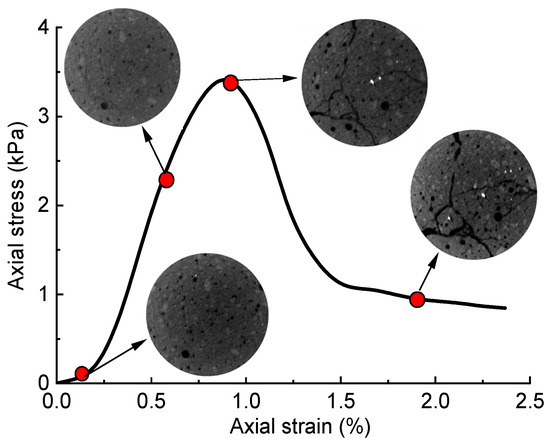
Figure 4.
σa–εa curves and real-time CT scanning points.
3.2. 2D Distribution Characteristics of Cracks
For the emphasis analysis of cracking characteristics, the 2D images of cracks within specimens were extracted from the grayscale slices (Figure 5). CT-n indicates the n-th CT scanning. By capturing images from the upper, middle, and lower sections of the specimens, the distribution of cracks exhibits inhomogeneity and anisotropy. During the compaction stage, the internal structure of the specimen of cemented backfill becomes more densely arranged, with a few small pores randomly distributed throughout the specimen and no obvious long cracks observed. In the elastic deformation stage, cracks appear at the top, middle, and bottom of the specimen. As the specimen undergoes yield deformation, compression fissure continues to expand, interconnect, and penetrate, meanwhile the width and length of these cracks significantly increase. In the residual deformation stage, there is a significant increase in the size and number of cracks, leading to improved connectivity of cracks and the formation of a complex network structure.
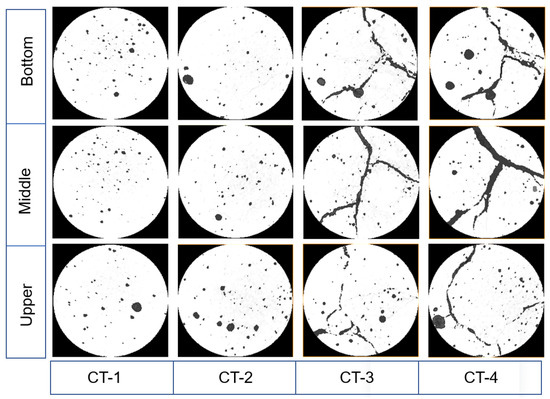
Figure 5.
CT images of specimen at different axial strains.
The 2D porosity () in CT images is calculated by pixel counts using Equation (1). Furthermore, the averaged value of 2D porosity () of the specimen at various axial strains is calculated using Equation (2).
where i is the serial number of CT images, k is the number of CT images, Aci refers to the area of cracks at the i-th CT image, and Ai signifies the total area i-th CT images of the specimen.
The 2D porosity at various heights of the specimen was computed using binarized CT images (Figure 6). The 2D porosity exhibits significant fluctuations along the height of the specimen under different strain conditions. The statistical analysis of the four different curves of the 2D porosity and the specimen heights reveal the upper endpoints of the curves exhibit an increasing trend with the number of scans, suggesting the vertical expansion of the destruction cracks. Statistical analysis results of the 2D CT data are presented in Table 2. With the gradual increase in axial strain, the pore areas in CFSG cemented backfill consistently enlarge. The 2D porosity, representing the proportion of pores to the total slice area, expanded from the initial measurement of 1.74% to 8.28%. The findings suggest a heightened level of structural damage to the specimen under external force. In Figure 6, along with an increase in strain, there is a corresponding increase in the variation of 2D porosity at different heights. This aligns with the observation that the statistical variance of the 2D porosity in Table 3 shows a continuous rise with the applied load. This phenomenon suggests that the application of uniaxial loading leads to a gradual increase in crack dispersion within the backfill material. Furthermore, the deformation process enhances the unevenness of the internal structure of the specimen.
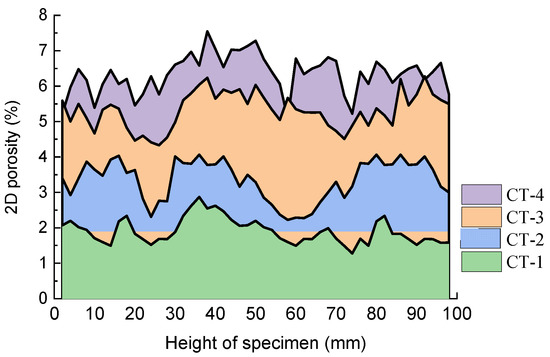
Figure 6.
Distribution of 2D crack ratio at different specimen heights.

Table 3.
Statistical data of crack areas in specimen.
3.3. 3D Crack Evolution Characteristics
By stacking 2D grayscale slices, conducting 3D reconstruction, and applying color rendering techniques, the cylindrical models of the cracks in the CFSG cemented backfill were generated (with a length of 50 mm, a diameter of 25 mm), as illustrated in Figure 7. The 3D reconstructed model of cracks acquired was delineated in four variations during the compressive deformation. The initial two scanned samples displayed elastic deformation, while the subsequent two exhibited plastic deformation. During the process of elastic deformation, internal cracks in the specimen developed gradually. However, upon entering the stage of plastic deformation, there was a significant increase in the rate of crack expansion. This phenomenon suggests that structural damage in backfilling under uniaxial loading is predominantly concentrated during the plastic deformation stage.
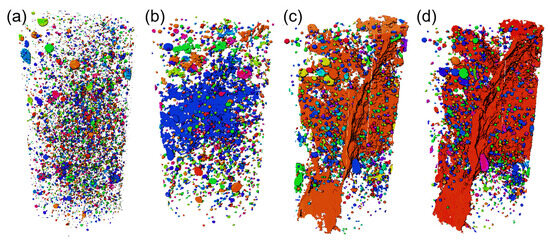
Figure 7.
3D crack models of specimen under uniaxial loading: (a) εa = 0.052%; (b) εa = 0.252; (c) εa = 0.952; (d) εa = 1.955.
According to An et al. [27], 3D reconstructed cracks in the specimen can be categorized as main cracks or minor cracks. Main cracks are characterized by an aspect ratio exceeding five and a volume exceeding 100 μm3. On the other hand, minor cracks are more widely distributed, have smaller volumes, and do not significantly contribute to the failure process of the specimen. From a qualitative perspective, the 3D reconstructed models form the CT scanning depicted in Figure 7 illustrate that in the initial state of the specimen, there are no apparent interconnected cracks. The statistical data for the 3D porosity of minor and main cracks in the CFSG cemented backfill under uniaxial loading are presented in Figure 8. From a quantitative perspective, the 3D porosity occupied by the main cracks (0.69%) are less than those of the minor cracks (1.13%). Upon entering elastic deformation, the main cracks start to interconnect, giving rise to a different fracture surface, albeit with a relatively small volume. The 3D porosity of the main cracks increases by 123.5% compared to the compaction stage, whereas that of the minor cracks decreases by 63.8%. As the specimen undergoes yield deformation, the width and length of main cracks increase, and the fracture surface propagates from the interior outward, indicating a rapid escalation of structural damage. The 3D porosity of the main cracks sharply increases to nearly 5%, while that of the minor cracks simultaneously slightly decreases. After residual deformation, there is an acceleration in the expansion rate and connectivity of the fracture surface, ultimately leading to the penetration of the 3D model of cracks. Statistically, the 3D porosity of main cracks increases to 5.62% following external loading, while that of minor cracks remains relatively constant.
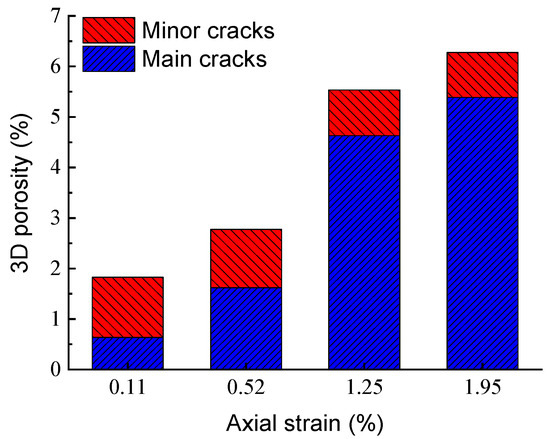
Figure 8.
3D porosity of minor and main cracks in the specimen under uniaxial loading.
In conclusion, Figure 7 and Figure 8 illustrate a reduction in both the quantity and size of minor cracks over time, implying that the application of compression leads to the closure of small-volume cracks. The porosity of the main cracks increases significantly under uniaxial loading, indicating irreparable damage to the structure of the cemented backfill [34]. As revealed by the quantitative results of crack classification, the proportion of small cracks decreased while that of cracks with large volumes and high connectivity increased as strain increased, which is consistent with the qualitative observations from 3D crack models (Figure 7). Therefore, the 3D reconstructed models of cracks and their statistical data derived from real-time CT scanning demonstrate a favorable visualization effect and accurate evaluation, offering an intuitive, quantitative, and dynamic representation of cracking behavior, particularly showcasing the evolution of fracture surfaces within the internal space of the detected specimens [35].
4. Discussion
During the deformation process of CFSG cemented backfill, the extent of material damage is intricately linked to the volume of fractures [36]. The study computed the structural damage variable Di by utilizing the volume of primary fractures Vi and the volume of secondary fractures Vi. This variable serves as a quantitative parameter for characterizing the extent of structural damage. Di denotes the ratio of fracture volume under load to the total fracture volume, which is calculated using the equation as follows:
where i represents the number of scans, with i = 1, 2, 3, 4.
Figure 7 presents the statistical results related to fracture volume, encompassing the total volume as well as primary and secondary fracture volumes. The analysis reveals that the volumes of total and primary fractures consistently exhibit an upward trend with strain, whereas the volume of secondary fractures demonstrates a declining pattern with the number of scans. This phenomenon suggests that primary fractures expand under uniaxial load, resulting in an increase in the total fracture volume, whereas secondary fractures experience a certain level of closure. The volume of fractures in CFSG cemented backfill exhibits gradual growth during the elastic deformation stage, followed by a sharp increase during the yield and residual deformation stages. Additionally, the proportion of primary fractures experiences a significant rise throughout the compression process.
The relationship curve illustrating the structural damage variable of the backfill, calculated from 3D fracture volume and axial strain, is presented in Figure 9. According to the data-fitting equation, the damage variable exhibits a logistic function increase with axial strain. The changing rate in the damage variable initially increases slowly, then accelerates rapidly before decelerating, indicating that the structural damage primarily occurs from elastic deformation to the yielding stage and stabilizes during the residual deformation stage. As the uniaxial loading increases, the internal fracture face within the specimen gradually expands and connects, resulting in alterations to damage variables. This process culminates in the development of fracture surfaces during the advanced stages of loading, leading to substantial structural deterioration, overall instability, and eventual failure of the specimen. The evolving trends observed in the damage variable derived from 3D volume of cracks suggest that the specimen experiences gradual instability and failure as it undergoes uniaxial compression [37]. Therefore, the expansion and interconnection of the fractures serve as the inherent causes for the structural damage and failure of the backfill body.
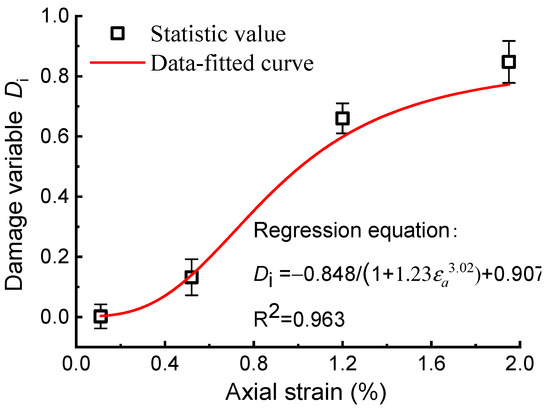
Figure 9.
Relationship between crack parameters and strains.
Analysis of damage variables indicates that the structural damage of the CFSG cemented backfill can be categorized into three phases, namely initiation, development, and stabilization. During the initiation of damage, the specimen primarily undergoes elastic deformation with minimal observable structural damage. During the damage development phase, there is a significant increase in plastic deformation. When the axial stress reaches its peak, the structural damage of the specimen is nearing its maximum. The final stage is the damage stabilization stage when the damage variable is at the peak value with little change. At this point, the axial stress begins to decrease, the specimen is raptured, and finally loses its bearing capacity [38].
The rate of the damage variable of the backfill materials was found to risen slowly initially, then rapidly during the yielding stages, and gradually decelerated during the late stage of deformation. This pattern of behavior is consistent with the expected response of materials under increasing stress [39].
According to Lemaitre’s strain equivalence hypothesis, the structural damage evolution equation of the specimen is presented in Equation (4).
where is the effective stress and is the initial elastic modulus.
According to the strain equivalent hypothesis, the elastic modulus varies as the degree of backfill damage increases. The damage evolution constitutive equation shown in Equation (5) is constructed based on the results of real-time CT scanning.
where Ei is the damaged elastic modulus.
Based on the linear rise and strain softening observed in the stress–strain curve, a mechanical constitutive model is proposed in accordance with the previous research [40]. The predicted stress–strain curve of the CFSG cemented backfill was obtained based on the damage variable, with the results presented in Figure 10. The fitting outcomes affirm that the aforementioned constitutive equation adeptly captures the stress–strain relationship of the specimen. This validation provides evidence for the accuracy and reliability of the constitutive model in predicting the behavior of this specific material under uniaxial loading conditions.
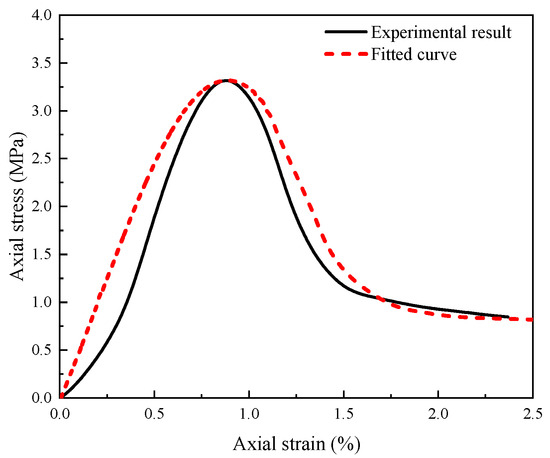
Figure 10.
The tested and predicted stress–strain curve of the CFSG cemented backfill.
It is evident that the measured stress–strain relationship of the specimen exhibits strain-softening behavior. Furthermore, the damage evolution constitutive model derived from damage variables effectively predicts the peak stress and accurately describes the stress–strain relationship at three stages of deformation: linear elastic deformation, plastic yield, and residual deformation during uniaxial compression. Both experimental and theoretical analyses have confirmed that the initiation and propagation of microcracks result in an accelerated accumulation of damage as the material undergoes deformation. However, the rate of damage accumulation increases significantly due to plastic deformation as the material reaches its ultimate strength and begins to yield. Finally, as the material approaches failure, the rate of damage accumulation slows down as it nears its breaking point. By investigating how cracks evolve under different loading conditions and their influence on the mechanical behavior of materials, we can gain valuable insights into predicting and preventing structural failure.
5. Conclusions
Through conducting experiments involving uniaxial compression and real-time CT scanning, qualitative and quantitative analyses were performed to investigate the fracture evolution pattern in cemented backfill mixed with solid wastes. This study aimed to reveal the internal damage characteristics of the specimens. The main conclusions drawn from the analysis are as follows:
- (1)
- When subjected to uniaxial loading, the σa–εa curve of CFSG cemented backfill displayed strain-softening characteristics. During the loading process, the specimens underwent four stages, namely compaction, elastic deformation, yielding, and residual deformation. The specimen exhibited an unconfined compressive strength of 3.44 MPa and a failure strain of 0.95%.
- (2)
- The 2D porosity at various heights of the specimens significantly increased with the rise in axial strain of CFSG cemented backfill. Furthermore, the dispersion of 2D porosity expanded with strain, suggesting that the heterogeneous distribution of internal cracks in the specimens was exacerbated during the compression deformation process.
- (3)
- Throughout the process of compression, 3D digital models effectively illustrated the dynamic progression of fracture surfaces emerging from the interior outward in the specimen. The volume and 3D porosity of cracks showed a gradual increase during the elastic deformation stage, followed by a rapid escalation during the yielding and residual deformation stages. Additionally, the proportion of main cracks experienced a significant rise throughout the compression process.
- (4)
- The development of microscopic fractures is the underlying cause of damage and deterioration in CFSG cemented backfill. The damage variable, derived from the volume of 3D cracks, exhibited an exponential growth pattern in response to strain. The change pattern of the damage variable suggests that the structural damage in the backfill material primarily transpired during the transition from the elastic deformation to yielding deformation stages, eventually reaching a stable state in the residual deformation stage.
- (5)
- The damage evolution model, based on real-time CT scanning, accurately depicts the stress–strain relationship during uniaxial compression of the CFSG cemented backfill. Therefore, understanding the cracking patterns can provide valuable insights for predicting structural damage and designing more resilient backfill materials for various mine applications.
Author Contributions
Conceptualization, B.S.; methodology, R.A.; formal analysis, H.L.; validation, X.Z.; investigation, B.S. and H.L.; resources, R.A.; writing—original draft preparation, B.S.; writing—review and editing, B.S. and H.L.; supervision, Z.Z.; funding acquisition, R.A.; visualization, Z.Z. All authors have read and agreed to the published version of the manuscript.
Funding
This research was funded by the National Natural Science Foundation of China (12102312); and the State Key Laboratory of Geomechanics and Geotechnical Engineering (SKLGME021018).
Data Availability Statement
Data are available upon reasonable request.
Acknowledgments
The authors thank the anonymous reviewers for their comments on this manuscript.
Conflicts of Interest
The authors declare no conflicts of interest.
References
- Wang, D.; Shi, C.; Farzadnia, N.; Shi, Z.G.; Jia, H.F.; Ou, Z.H. A review on use of limestone powder incement-based materials: Mechanism, hydration and microstructures. Constr. Build. Mater. 2018, 181, 659–672. [Google Scholar] [CrossRef]
- Xue, G.L.; Yilmaz, E.; Song, W.D.; Cao, S. Mechanical, flexural and microstructural properties of cement-tailingsmatrix composites: Effects of fiber type and dosage. Compos. Part B Eng. 2019, 172, 131–142. [Google Scholar] [CrossRef]
- Walske, M.L.; McWilliam, H.; Doherty, J.; Fourie, A. Influence of cur-ing temperature and stress conditions on mechanical properties of cementing paste backfill. Can. Geotech. J. 2016, 53, 148–161. [Google Scholar] [CrossRef]
- Heikal, M.; Ali, M.A.; Ghernaout, D.; Elboughdiri, N.; Ghernaout, B.; Bendary, H.I. Prolonging the Durability of Maritime Constructions through a Sustainable and Salt-Resistant Cement Composite. Materials 2023, 16, 6876. [Google Scholar] [CrossRef]
- Ye, G.; Liu, X.; De Schutter, G.; Poppe, A.M.; Taerwe, L. Influence of limestone powder used as filler in SCCon hydration and microstructure of cement pastes. Cem. Concr. Res. 2007, 29, 94–102. [Google Scholar] [CrossRef]
- Heikal, M.; ·Ali, M.A.; ·Ibrahim, S.M.; ·Bendary, H.I. Sustainable composite cement prepared by two different types of iron slag. J. Mater. Cycles Waste 2024, 26, 331–345. [Google Scholar] [CrossRef]
- Zhao, K.; Li, W.; Ding, H.; Zeng, P.; Xiang, W.; Zhang, M.; Liu, Z.; Li, Y. Experimental study on themechanical and acoustic characteristics of cemented backfillwith unclassified tailings at different curing ages under uniaxia lcompression. Sustainability 2023, 15, 7177. [Google Scholar] [CrossRef]
- Koohestani, B.; Belem, T.; Koubaa, A.; Bussière, B. Experimental investigation into the compressive strength development of cemented paste backfill containing Nano-silica. Cem. Concr. Compos. 2016, 72, 180–189. [Google Scholar] [CrossRef]
- Qiu, J.-P.; Yang, L.; Xing, J.; Sun, X.-G. Analytical Solution for Determining the Required Strength of Mine Backfill Based on its Damage Constitutive Model. Soil Mech. Found. Eng. 2018, 54, 371–376. [Google Scholar] [CrossRef]
- Hu, J.; Ren, Q.; Jiang, Q.; Gao, R.; Zhang, L.; Luo, Z. Strength Characteristics and the Reaction Mechanism of Stone Powder Cement Tailings Backfill. Adv. Mater. Sci. Eng. 2018, 2018, 8651239. [Google Scholar] [CrossRef]
- An, R.; Zhang, X.; Wang, Y.; Chen, C.; Chen, X. Dynamic evolution of cracks in slag-modified soil under uniaxial loading using real-time X-ray computed tomography. J. Mater. Civ. Eng. 2023, 35, 14491. [Google Scholar] [CrossRef]
- Jabłońska, B.; Kityk, A.V.; Busch, M.; Huber, P. The structural and surface properties of natural and modified coal gangue. J. Environ. Manag. 2017, 190, 80–90. [Google Scholar] [CrossRef]
- Zhou, X.; Zhang, Y.; Ha, Q. Real-time computerized tomography (CT) experiments on limestone damage evolution during unloading. Theor. Appl. Fract. Mech. 2008, 50, 49–56. [Google Scholar] [CrossRef]
- Yuan, Z.; Gao, L.; Chen, H.; Song, S. Study on Settlement ofSelf-Compacting Solidified Soil inFoundation Pit Backfilling Based onGA-BP Neural Network Model. Buildings 2023, 13, 2014. [Google Scholar] [CrossRef]
- Wang, Y.; Li, X.; Wu, Y.F.; Lin, C.; Zhang, B. Experimental study on meso-damage cracking characteristics of RSA by CT test. Environ. Earth Sci. 2015, 73, 5545–5558. [Google Scholar] [CrossRef]
- Liu, K.; Zhang, X.; Chen, Y. Extraction of coal and gangue geometric features with multifractaldetrending fluctuation analysis. Appl. Sci. 2018, 8, 463. [Google Scholar] [CrossRef]
- Querol, X.; Izquierdo, M.; Monfort, E.; Alvarez, E.; Font, O.; Moreno, T.; Alastuey, A.; Zhuang, X.; Lu, W.; Wang, Y. Environmental characterization of burnt coal gangue banks at Yangquan, Shanxi Province, China. Int. J. Coal Geol. 2008, 75, 93–104. [Google Scholar] [CrossRef]
- Yang, J.; Yang, B.; Yu, M. Pressure Study on Pipe Transportation Associated with Cemented Coal Gangue Fly-Ash Backfill Slurry. Appl. Sci. 2019, 9, 512. [Google Scholar] [CrossRef]
- Li, J.; Huang, Y.; Chen, Z.; Zhang, J.; Jiang, H.; Zhang, Y. Characterizations of macroscopic deformation and particle crushing of crushed gangue particle material under cyclic loading: In solid backfilling coal mining. Powder Technol. 2019, 343, 159–169. [Google Scholar] [CrossRef]
- Yilmaz, E.; Belem, T.; Benzaazoua, M.; Kesimal, A.; Ercikdi, B. Evaluation of the strength properties of deslimed tailings paste backfill. Miner. Resour. Eng. 2007, 12, 129–144. [Google Scholar]
- Zhou, C.; Liu, G.; Wu, S.; Lam, P.K.S. The environmental characteristics of usage of coal gangue in bricking-making: A case study at Huainan, China. Chemosphere 2014, 95, 274–280. [Google Scholar] [CrossRef]
- Li, Y.; Yao, Y.; Liu, X.; Sun, H.; Ni, W. Improvement on pozzolanic reactivity of coal gangue by integrated thermal and chemical activation. Fuel 2013, 109, 527–533. [Google Scholar] [CrossRef]
- Bian, Z.; Dong, J.; Lei, S.; Leng, H.; Mu, S.; Wang, H. The impact of disposal and treatment of coal mining wastes on environment and farmland. Environ. Geol. 2009, 58, 625–634. [Google Scholar] [CrossRef]
- Wang, J.; Qin, Q.; Hu, S.; Wu, K. A concrete material with waste coal gangue and fly ash used for farmland drainage in high groundwater level areas. J. Clean. Prod. 2016, 112, 631–638. [Google Scholar] [CrossRef]
- Wu, Y.; Wang, D.; Wang, L.; Shang, Z.; Zhu, C.; Wei, J.; Yuan, A.; Zhang, H.; Zeng, F. An analysis of the meso-structural damage evolution of coal using X-ray CT and a gray-scale level co-occurrence matrix method. Int. J. Rock Mech. Min. Sci. 2022, 152, 105062. [Google Scholar] [CrossRef]
- Wang, C.W.X. In situ X-ray computed tomography (ct) investigation of crack damage evolution for cemented paste backfill with marble waste block admixture under uniaxial deformation. Arab. J. Geosci. 2020, 13, 1018. [Google Scholar] [CrossRef]
- An, R.; Wang, Y.X.; Zhang, X.; Chen, C.; Liu, X.; Cai, S. Quantitative characterization of drying-induced cracks and permeabilityof granite residual soil using micron-sized x-ray computed tomography. Sci. Total Environ. 2023, 876, 163213. [Google Scholar] [CrossRef]
- Li, Y.; Cui, H.; Zhang, P.; Wang, D.; Wei, J. Three-dimensional visualization and quantitative characterization of coal fracture dynamic evolution under uniaxial and triaxial compression based on μCT scanning. Fuel 2020, 262, 116568. [Google Scholar] [CrossRef]
- Sun, X.; Li, X.; Zheng, B.; He, J.; Mao, T. Study on the progressive fracturing in soil and rock mixture under uniaxial compression conditions by CT scanning. Eng. Geol. 2020, 279, 105884. [Google Scholar] [CrossRef]
- Sun, W.; Wu, A.; Hou, K.; Yang, Y.; Liu, L.; Wen, Y. Real-time observation of meso-fracture process in backfill body during mine subsidence using X-ray CT under uniaxial compressive conditions. Constr. Build. Mater. 2016, 113, 153–162. [Google Scholar] [CrossRef]
- Duan, Y.; Li, X.; Zheng, B.; He, J.; Hao, J. Cracking Evolution and Failure Characteristics of Longmaxi Shale Under Uniaxial Compression Using Real-Time Computed Tomography Scanning. Rock Mech. Rock Eng. 2019, 52, 3003–3015. [Google Scholar] [CrossRef]
- Li, Y.; Xue, L.; Wu, X. Study on acoustic emission and X-ray computed-tomography characteristics of shale samples under uniaxial compression tests. Environ. Earth Sci. 2019, 78, 173. [Google Scholar] [CrossRef]
- Wang, Y.; Li, C.; Hu, Y. 3D image visualization of meso-structural changes in a bimsoil under uniaxial compression using X-ray computed tomography (CT). Eng. Geol. 2019, 248, 61–69. [Google Scholar] [CrossRef]
- Song, Y.; Cao, J.; Ding, W.; Song, Z.; Liu, H.; Huang, S.; Zhu, W. Influence of peat soil environment on mechanical properties of cement-soil and its mechanism. Sustainability 2023, 15, 4580. [Google Scholar] [CrossRef]
- Wang, J.; Xing, M.; Yang, X.; Jiao, H.; Chen, F.; Yang, L.; Yu, J.; Fu, Y. Review on the Influence andControl of Sulfur-Containing Tailingson the Strength of Cemented Backfillin Metal Mines. Buildings 2023, 13, 51. [Google Scholar] [CrossRef]
- Meng, Q.; Wu, K.; Zhou, H.; Qin, Q.; Wang, C. Mesoscopic damage evolution of coral reef limestone based on real-time CT scanning. Eng. Geol. 2022, 307, 106781. [Google Scholar] [CrossRef]
- Li, X.; Lu, Y.D.; Zhang, X.Z.; Lu, Y.C.; Yang, Y.H. Pore-fissure identification and characterization of paleosol based on X-ray computed tomography. Bull. Soil Water Conserv. 2018, 38, 224–230+239. [Google Scholar]
- Zhao, Y.; Ling, X.; Gong, W.; Li, P.; Li, G.; Wang, L. Mechanical properties of fiber-reinforced soil under triaxial compression and parameter determination based on the Duncan-Chang model. Appl. Sci. 2020, 10, 9043. [Google Scholar] [CrossRef]
- Fleury, M.P.; Kamakura, G.K.; Pitombo, C.S.; Cunha, A.L.B.N.; Ferreira, E.B.; Lins da Silva, J. Assessing and predicting geogridreduction factors after damageinduced by dropping recycledaggregates. Sustainability 2023, 15, 9942. [Google Scholar] [CrossRef]
- Xie, S.; Lin, H.; Chen, Y.; Yong, R.; Xiong, W.; Du, S. A damage constitutive model for shear behavior of joints based on determination of the yield point. Int. J. Rock Mech. Min. Sci. 2020, 128, 104269. [Google Scholar] [CrossRef]
Disclaimer/Publisher’s Note: The statements, opinions and data contained in all publications are solely those of the individual author(s) and contributor(s) and not of MDPI and/or the editor(s). MDPI and/or the editor(s) disclaim responsibility for any injury to people or property resulting from any ideas, methods, instructions or products referred to in the content. |
© 2024 by the authors. Licensee MDPI, Basel, Switzerland. This article is an open access article distributed under the terms and conditions of the Creative Commons Attribution (CC BY) license (https://creativecommons.org/licenses/by/4.0/).